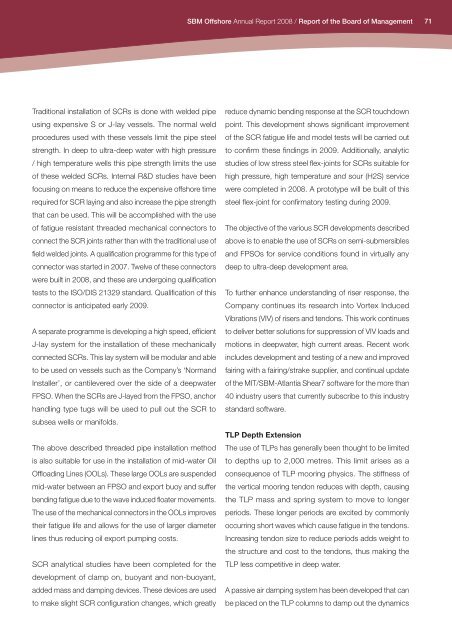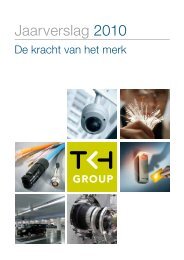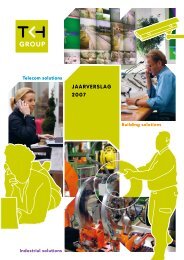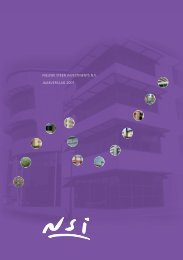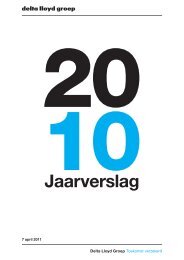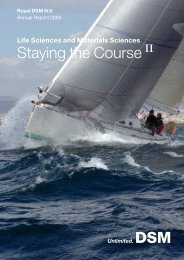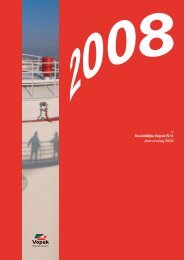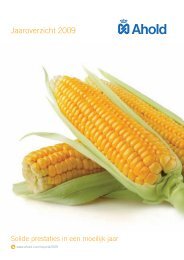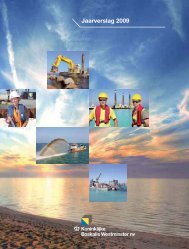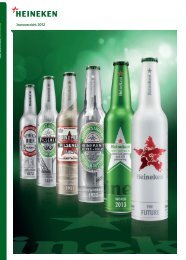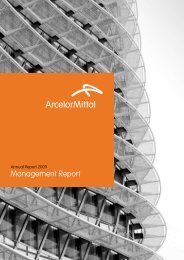2008 Annual Report - SBM Offshore
2008 Annual Report - SBM Offshore
2008 Annual Report - SBM Offshore
- No tags were found...
Create successful ePaper yourself
Turn your PDF publications into a flip-book with our unique Google optimized e-Paper software.
<strong>SBM</strong> <strong>Offshore</strong> <strong>Annual</strong> <strong>Report</strong> <strong>2008</strong> / <strong>Report</strong> of the Board of Management71Traditional installation of SCRs is done with welded pipeusing expensive S or J-lay vessels. The normal weldprocedures used with these vessels limit the pipe steelstrength. In deep to ultra-deep water with high pressure/ high temperature wells this pipe strength limits the useof these welded SCRs. Internal R&D studies have beenfocusing on means to reduce the expensive offshore timerequired for SCR laying and also increase the pipe strengththat can be used. This will be accomplished with the useof fatigue resistant threaded mechanical connectors toconnect the SCR joints rather than with the traditional use offield welded joints. A qualification programme for this type ofconnector was started in 2007. Twelve of these connectorswere built in <strong>2008</strong>, and these are undergoing qualificationtests to the ISO/DIS 21329 standard. Qualification of thisconnector is anticipated early 2009.A separate programme is developing a high speed, efficientJ-lay system for the installation of these mechanicallyconnected SCRs. This lay system will be modular and ableto be used on vessels such as the Company’s ‘NormandInstaller’, or cantilevered over the side of a deepwaterFPSO. When the SCRs are J-layed from the FPSO, anchorhandling type tugs will be used to pull out the SCR tosubsea wells or manifolds.The above described threaded pipe installation methodis also suitable for use in the installation of mid-water OilOffloading Lines (OOLs). These large OOLs are suspendedmid-water between an FPSO and export buoy and sufferbending fatigue due to the wave induced floater movements.The use of the mechanical connectors in the OOLs improvestheir fatigue life and allows for the use of larger diameterlines thus reducing oil export pumping costs.SCR analytical studies have been completed for thedevelopment of clamp on, buoyant and non-buoyant,added mass and damping devices. These devices are usedto make slight SCR configuration changes, which greatlyreduce dynamic bending response at the SCR touchdownpoint. This development shows significant improvementof the SCR fatigue life and model tests will be carried outto confirm these findings in 2009. Additionally, analyticstudies of low stress steel flex-joints for SCRs suitable forhigh pressure, high temperature and sour (H2S) servicewere completed in <strong>2008</strong>. A prototype will be built of thissteel flex-joint for confirmatory testing during 2009.The objective of the various SCR developments describedabove is to enable the use of SCRs on semi-submersiblesand FPSOs for service conditions found in virtually anydeep to ultra-deep development area.To further enhance understanding of riser response, theCompany continues its research into Vortex InducedVibrations (VIV) of risers and tendons. This work continuesto deliver better solutions for suppression of VIV loads andmotions in deepwater, high current areas. Recent workincludes development and testing of a new and improvedfairing with a fairing/strake supplier, and continual updateof the MIT/<strong>SBM</strong>-Atlantia Shear7 software for the more than40 industry users that currently subscribe to this industrystandard software.TLP Depth ExtensionThe use of TLPs has generally been thought to be limitedto depths up to 2,000 metres. This limit arises as aconsequence of TLP mooring physics. The stiffness ofthe vertical mooring tendon reduces with depth, causingthe TLP mass and spring system to move to longerperiods. These longer periods are excited by commonlyoccurring short waves which cause fatigue in the tendons.Increasing tendon size to reduce periods adds weight tothe structure and cost to the tendons, thus making theTLP less competitive in deep water.A passive air damping system has been developed that canbe placed on the TLP columns to damp out the dynamics


